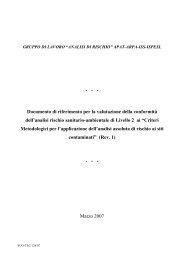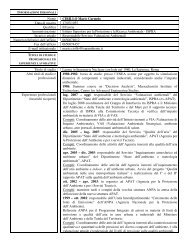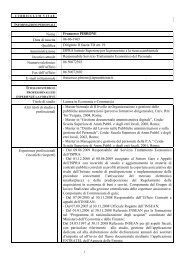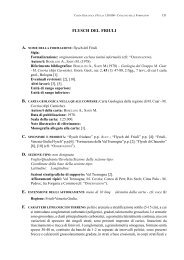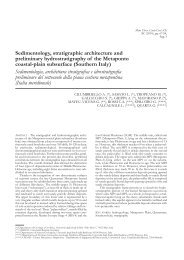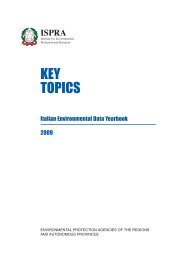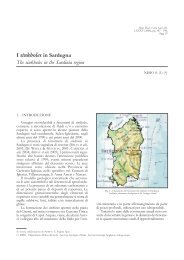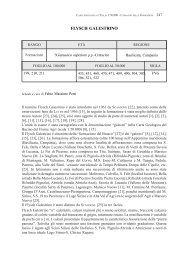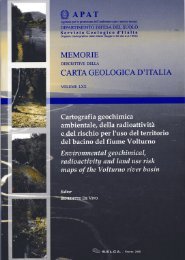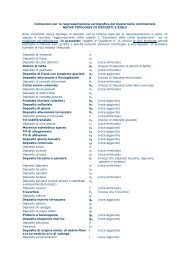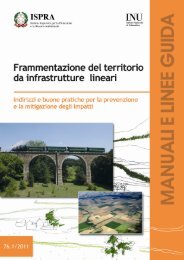Guidebook - Ispra
Guidebook - Ispra
Guidebook - Ispra
You also want an ePaper? Increase the reach of your titles
YUMPU automatically turns print PDFs into web optimized ePapers that Google loves.
THE APULIA CARBONATE PLATFORM-MARGIN AND SLOPE, LATE JURASSIC TO<br />
EOCENE OF THE MAIELLA MT. AND GARGANO PROMONTORY:<br />
PHYSICAL STRATIGRAPHY AND ARCHITECTURE P18<br />
Figure 7 - Satellite image (Landsat TM) of the Gargano Promontory. The Mattinata Fault is the main E-W striking<br />
alignement visible in the southern part of the image<br />
up during time. Only during the Late Cretaceous,<br />
the paleoescarpment was sealed and the platform<br />
architecture changed from aggrading to prograding<br />
(Crescenti et al., 1969; Eberli et al., 1993). A more<br />
recent sedimentary model is proposed by Morsilli<br />
et al. (2002). They consider the paleoescarpment<br />
as the remnant surface of a series of submarine<br />
landslides, formed during an imposing phase of<br />
platform margin collapses. Successively, through a<br />
mechanical quantitative modelling, Rusciadelli et al.<br />
(2003) highlighted the fundamental role of earthquake<br />
swarms in the formation of the large-scale margin<br />
collapses.<br />
The geological framework of the<br />
Gargano Promontory<br />
The Gargano Promontory is a gentle NW-SE trending<br />
regional anticline where the oldest units of Late<br />
Jurassic age reach an elevation of 1000 m. The<br />
structure is complicated by several E-W, NE-SW<br />
and NW-SE trending steep to subvertical normal<br />
and strike-slip faults (Figure7). One of the most<br />
impressive structural features of the Gargano is a<br />
major E-W horizontal shear zone (Val Carbonara<br />
Fault, Mattinata Fault or Mattinata-Gondola Fault<br />
Zone). As shown by seismic profi les, the Mattinata<br />
Fault continues offshore for tens of kilometres<br />
(Gondola Line of De Dominicis and Mazzoldi, 1989).<br />
Quite controversial is the kinematics of this structure.<br />
It has been interpreted as right-lateral (Guerricchio,<br />
1986, 1996; Finetti and Del Ben, 1986; De Dominicis<br />
and Mazzoldi, 1989; Bosellini et al., 1993; Doglioni<br />
et al., 1994), left-lateral (Funiciello et al., 1992; Favali<br />
et al., 1992; Salvini et al., 1999; Billi, 2003), right-<br />
to left-lateral inverted (de Alteriis, 1995; Gambini<br />
and Tozzi, 1996) or as a reverse fault (Ortolani and<br />
Pagliuca, 1989). The Mattinata fault is a complex<br />
structure that records different kinematics related to<br />
changes in the stress regime through time (Morsilli,<br />
1998). Chilovi et al. (2000) indicate a complex history<br />
of this structure: Mesozoic extensional regime,<br />
followed by a Late Miocene to Early Pliocene leftlateral<br />
displacement and Late Pliocene to Quaternary<br />
right-lateral activity.<br />
Recently, the Gargano has been interpreted as a<br />
Neogene contractional belt (Bertotti et al., 1999)<br />
with many thrust structures previously interpreted as<br />
normal faults (Figure8). Until the early Miocene, the<br />
Gargano was poorly deformed, but during Langhian<br />
to Tortonian times a tectonic phase starts to deform<br />
the previous and sindepositional units with gentle<br />
folds and thrusts. Between the Late Miocene and the<br />
early (?) Pliocene, NE-SW trending normal faults<br />
developed in the Gargano area, leading fi nally the<br />
9 - P18<br />
Volume n° 3 - from P14 to P36



